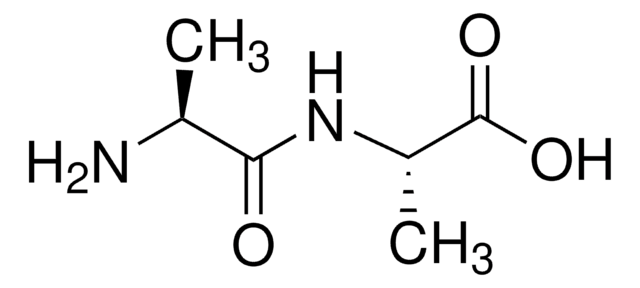G8541
Ala-Gln
200 mM, solution, sterile-filtered, Biotechnology Performance Certified
Sinónimos:
Alanyl-glutamine, Glutamine-S
About This Item
Productos recomendados
grado
Biotechnology Performance Certified
Nivel de calidad
esterilidad
sterile-filtered
formulario
solution
concentración
200 mM
impurezas
endotoxin, tested
temp. de almacenamiento
2-8°C
cadena SMILES
NC(CC[C@H](NC([C@@H](N)C)=O)C(O)=O)=O
InChI
1S/C8H15N3O4/c1-4(9)7(13)11-5(8(14)15)2-3-6(10)12/h4-5H,2-3,9H2,1H3,(H2,10,12)(H,11,13)(H,14,15)/t4-,5-/m0/s1
Clave InChI
HJCMDXDYPOUFDY-WHFBIAKZSA-N
¿Está buscando productos similares? Visita Guía de comparación de productos
Descripción general
Aplicación
Otras notas
Código de clase de almacenamiento
10 - Combustible liquids
Clase de riesgo para el agua (WGK)
WGK 1
Punto de inflamabilidad (°F)
Not applicable
Punto de inflamabilidad (°C)
Not applicable
Certificados de análisis (COA)
Busque Certificados de análisis (COA) introduciendo el número de lote del producto. Los números de lote se encuentran en la etiqueta del producto después de las palabras «Lot» o «Batch»
¿Ya tiene este producto?
Encuentre la documentación para los productos que ha comprado recientemente en la Biblioteca de documentos.
Los clientes también vieron
Artículos
Importance and uses of glutamine in hybridoma and mammalian cell culture
Organoid culture products to generate tissue and stem cell derived 3D brain, intestinal, gut, lung and cancer tumor organoid models.
Nuestro equipo de científicos tiene experiencia en todas las áreas de investigación: Ciencias de la vida, Ciencia de los materiales, Síntesis química, Cromatografía, Analítica y muchas otras.
Póngase en contacto con el Servicio técnico








